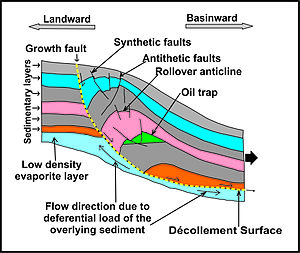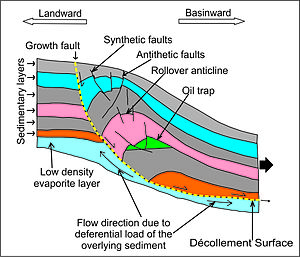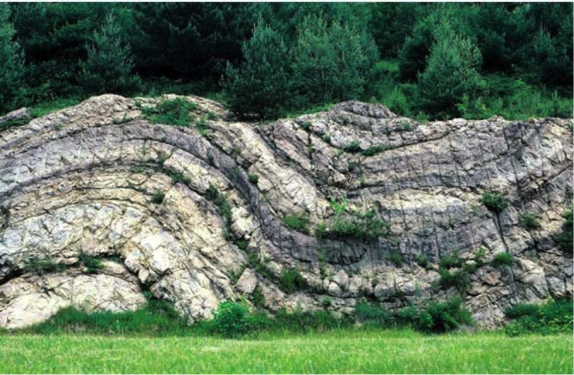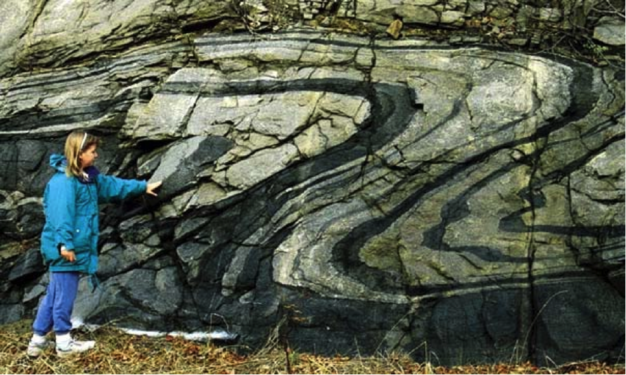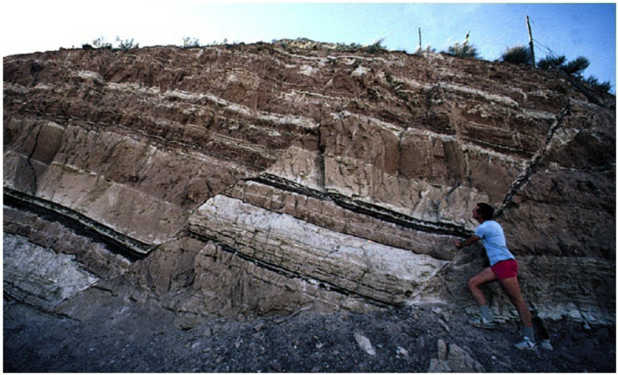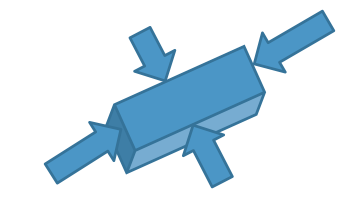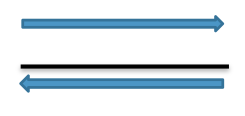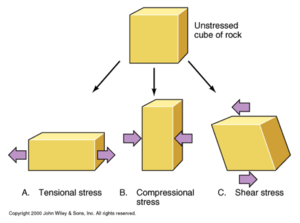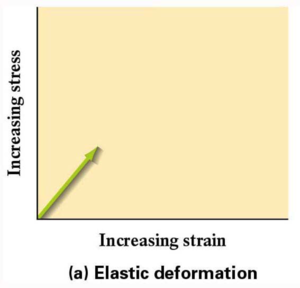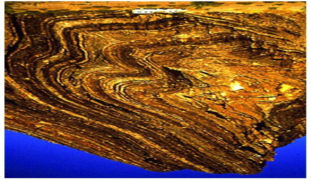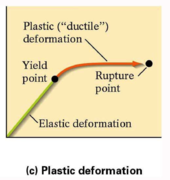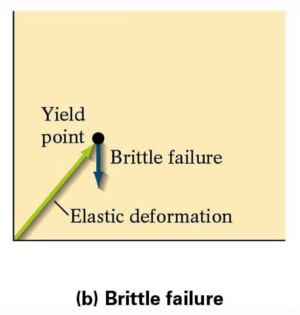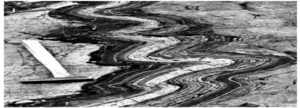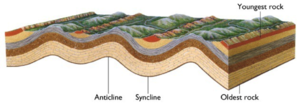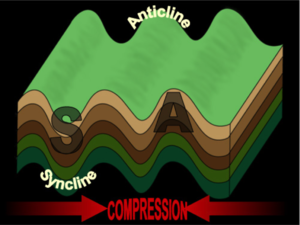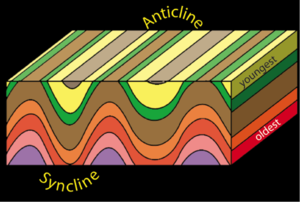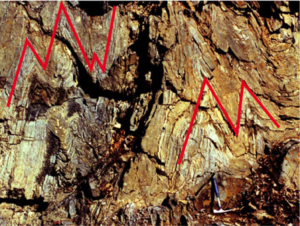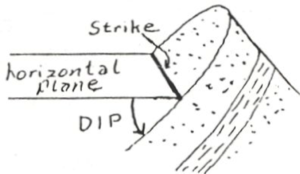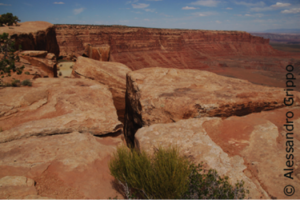Structural geology
| Wiki Write-Off Entry | |
|---|---|

| |
| Student Chapter | University of Ilorin |
| Competition | December 2014 |
Structural geology is the study of the three-dimensional distribution of rock units with respect to their deformational histories. The primary goal of structural geology is to use measurements of present-day rock geometrics to uncover information about the history of deformation (strain) in the rocks, and ultimately, to understand the stress field that resulted in the observed strain and geometrics. This understanding of the dynamics of the stress field can be linked to important events in the regional geologic past; a common goal is to understand the structural related evolution of a particular area with respect to regionally widespread patterns of rock deformation (mountain building, rifting )due to plate tectonics
Growth fault
Growth faults are syndepositional or synsedimentary extensional faults that initiate and evolve at the margins of continental plates. They extend parallel to passive margins that have high sediment supply. Their fault plane dips mostly toward the basin and has long-term continuous displacement. Figure 1 shows a growth fault with a concave upward fault plane that has high updip angle and flattened at its base into zone of detachment. This angle is continuously changing from nearly vertical in the up dip area to nearly horizontal in the down dip area.
Growth faults maturation is a long term process that takes millions of years with slip rate ranges between 0.2-1.2 millimeters per year. It starts when sedimentary sequences are deposited on top of each other above a thick evaporite layer (Figure 2). A growth fault is initiated when the evaporite layer can no longer support the overlying sequences. The thicker and denser portion applies much more pressure on the evaporite layer than the thin portion. As a result, a flow within the evaporite layer is initiated from high pressure areas toward low pressure areas causing growth ridges to form below the thin portion. Also, sinking zones are noticed among these ridges at areas where thicker and denser layers form (Figure 2).
Accompanied structures
Growth faults have two blocks. The upthrown block – the footwall – is landward of the fault plane and the downthrown block – the hanging wall – is basinward of the fault plane. Most deformations occur within the hanging wall side. The downthrown block slips downward and basinward relative to the upthrown block. This is caused due to the differential load of the overlying sediments and the high mobility of the lowermost low density layer.
Driving force
The main driving forces of the growth faults are the deferential sediments load and the low density layers - evaporites or over-pressured shale - that are formed during or right after the rifting process. Growth faults are located mainly within passive margin sedimentary wedges where tectonic forces have minimum or no effect. These passive margins receive millions of tons of sediments every year which are concentrated on the continental shelf below base level and above areas where the water velocity is no longer supporting the particles weight. This zone is called depositional center (depocenter for short) and has higher sediments load.Earthquakes arise and result ease of the force along the growth fault plane.
Importance of growth faults
Growth faults have great significance for stratigraphy, structural geology and the petroleum industry. They account for relative and eustatic sea level changes and accommodation space left for new sediments. Likewise, growth faults are connected directly to the subsidence in the coastal and continental shelf areas. Moreover, they explain lateral thickness variation of sedimentary sequences across these faults. The updip area on the downthrown block is the main target of oil and gas exploration because it has synthetic and antithetic faults and rollover anticlines. These are considered as structural traps preventing oil and gas from escaping
Deformation of rocks
Rock Deformation
- Large scale deformation of the Earth’s crust = plate tectonics
- Smaller scale deformation = structural geology
Deformation of rocks
- Folds and faults are geologic structures
Deformation – Stress vs. Strain
- Changes in volume or shape of a rock body = strain
Stress
- The force that acts on a rock unit to change its shape and/or its volume Causes strain or deformation.
Types of directed Stress include
- Compression
- Action of coincident oppositely directed forces acting towards each other
- Tension
- Action of coincident oppositely directed forces acting away from each other
- Shear
- Action of coincident oppositely directed forces acting parallel to each other across a surface
Strength
- Ability of an object to resist deformation
- Compressive
- Capacity of a material to withstand axially directed pushing forces – when the limit of compressive strength is reached, materials are crushed
- Tensile
- Measures the force required to pull something such as rope, wire, or a rock to the point where it breaks
Strain
- Any change in original shape or size of an object in response to stress acting on the object
Kinds of deformation
- Elastic vs Plastic
- Brittle vs Ductile
Elastic Deformation
- Temporary change in shape or size that is recovered when the deforming force is removed
Ductile (Plastic) Deformation
- Permanent change in shape or size that is not recovered when the stress is removed
- Occurs by the slippage of atoms or small groups of atoms past each other in the deforming material, without loss of cohesion
Brittle Deformation (Rupture)
- Loss of cohesion of a body under the influence of deforming stress
- Usually occurs along sub-planar surfaces that separate zones of coherent material
Factors that affect deformation
- Temperature
- Pressure
- Strain rate
- Rock type
The variation of these factors determines if a rock will fault or fold.'
Brittle Failure Rocks are:
- Elastic and brittle near the earth's surface
- More plastic and ductile deeper in the crust
- Because of the increasing temperature and pressure
Folds
- Most common ductile response to stress on rocks in the earth's crust
Effects of Rock Type on Deformation
Some rocks are stronger than others
- Competent: rocks that deform only under great stress
- incompetent: rocks that deform undermoderate to lowstresses.
Types of Folds (bent planar structures)
- Anticline: older rocks on the inside
- Syncline: older rocks on the outside
- (scale - from mm to tens of km)
Anticlines and Synclines
Acticlines and synclines are the up and down folds that usually occur together and are caused by compressional stress.
- Anticlines are folds in which each half of the fold dips away from the crest.
- Synclines are folds in which each half of the fold dips toward the trough of the fold. You can remember the difference by noting that anticlines form an “A” shape, and synclines form the bottom of an “S.”
After erosion has occurred, geologists can use the patterns of rocks on the surface to determine where anticlines and synclines exist. In the block diagram above, the top of the block represents the ground surface and what would be shown on a geologic map. The sides of the block show the underground geology. In anticlines, as seen on the ground, the oldest rocks are in the center of the fold. In synclines, the youngest rocks are in the center of the fold.
This intensely folded limestone from Highland County shows how anticlines and synclines typically occur together. These sharp folds are called "chevron" folds.
Fold Terms
- axial plane
- the plane of mirror symmetry dividing the fold into two limbs
- axis
- line formed by the intersection of the axial plane and a bedding plane
- horizontal fold
- where the fold axis is horizontal
- plunging fold
- where the fold axis is not horizontal
Measuring dip and strike
Equipment needed:
- A compass for measuring direction of dip and strike.
- A clinometer for reading angle of dip.
- These two are usually combined in a compass clinometer.
- A soft pencil, a hard pencil and an eraser
- Fieldwork notebook
The angle of dip is the angle between the bedding plane and the horizontal. The strike is the horizontal line which is at 90 to the direction of dip.
Method for measuring dip and strike:
- Set the clinometer so that 90 and 270 on the dial are lined up with the markers on the clinometer and the inner scale reads 0 when the instrument is horizontal.
- Place the clinometer on the bedding plane and move it around until a reading of 0 is obtained.
- Draw a soft pencil line on the bedding plane to mark where the base of the clinometer rests on the rock. Since this line is horizontal, it will show the direction of strike.
- Draw another line on the rock so that it is at right angles to the direction of strike and points directly down the sloping bedding plane. This line marks the direction of dip.
- Using the clinometer, measure the angle of dip by placing the clinometer along the line which shows the direction of dip.
- Using a compass measure the direction of strike and the direction of dip, as shown by the lines drawn on the rock.
- Record the Grid Reference of the location, the strike direction in degrees and the dip direction in degrees.
Fracture
Fractures are surfaces along which rocks or minerals have broken, thus generating two free surfaces where none existed before.
Fractures are among the most common of all geologic features. Their study is important because fractures provide information on what kind of stress caused them (history of deformation) and also because they alter the characteristics of the rocks in which they occur: for instance a fracture would weaken a rock (and we need to know that if we build a dam, or a tunnel), and would allow fluids to move through it (and we need to know that if we are looking for oil or gas, or if we are dealing with groundwater. Fractures and joint are similar
Fracture
- Most common brittle response to stress
- With No displacement = Joint
- With displacement = Fault
Joints commonly form when the surface of a volcanic rock cools and contracts
Faults
- Occur when large stresses build up inthe crust.
- Classified according to the kind of movement that has occurred along them.
This movement within the earth's crust usually generates an earthquake.
Application of structural geology
- Engineering issues, bridges, dams, highway cuts, large buildings, airports etc.
- Environmental issues
- Earthquake hazard
- Locations of landfill sites contamination
- Ground water and mineral exploration
- Mining and explorations of minerals
Conclusion
The study of geological structure have been prime importance in economic geology, both petroleum geology and mining geology. Folded and faulted rocs strata commonly forms traps for the accumulation and concentration of fluids such as petroleum and natural gas. Faulted and structural complex areas are noted as permeable zone for hydrothermal fluids and the resulting concentration areas for base and precious metal ORE deposits.
Sources
- Cazes, C. A., 2004, Overlap zones, growth faults, and sedimentation: Using high resolution gravity data, Livingston Parish, LA: Faculty of the Louisiana State University and Agricultural and Mechanical College in partial fulfillment of the requirements for the degree of Master of Science in The Department of Geology and Geophysics; Thesis, Louisiana State University, p. 147.
- Schlische, R. W., M. H. Anders, 1996, Stratigraphic effects and tectonic implications of the growth of normal faults and extensional basins, "in" K. Berata, ed., Reconstructing the History of the Basin and Range Extension using Sedimentology and Stratigraphy: Geological Society of America Memoir 303, pp. 183–203.
- Doglioni, C., N. D’Agostino, and G. Mariotti, 1998, Normal faulting versus regional
- http://Homepage.smc.edu/grippo-alessandro/strct3.html
- Wikipedia, the free encyclopedia
- Structural geology
- [1]
